Goa,India
To Know More About Goa

Goa Variously known as "Pearl of the Orient" and a "Tourist Paradise", the state of Goa is located on the western coast of India in the coastal belt known as Konkan, it is bounded by the state of Maharashtra to the north, Karnataka to the east and south and the Arabian Sea forms its western coast.
The magnificent scenic beauty and the architectural splendours of its temples, churches and old houses have made Goa a firm favourite with travellers around the world. But then, Goa is much more than just beaches and sea. It has a soul which goes deep into unique history, rich culture and some of the prettiest natural scenery that India has to offer. Much of the real Goa is in its interiors, both inside its buildings and in the hinterland away from the coastal area. Legends from Hindu mythology credit Lord Parshuram, an incarnation of Lord Vishnu with the creation of Goa. Over the centuries various dynasties have ruled Goa. Rashtrakutas, Kadambas, Silaharas, Chalukyas, Bahamani Muslims and most famously the Portuguese have been rulers of Goa.
Goa was liberated by the Indian Army from Portuguese colonisation on December 19, 1961 and became an Union Territory along with the enclaves of Daman and Diu. On May 30, 1987 Goa was conferred statehood and became the 25th state of the Indian Republic.
Having been the meeting point of races, religions and cultures of East and West over the centuries, Goa has a multi-hued and distinctive lifestyle quite different from the rest of India. Hindu and Catholic communities make up almost the entire population with minority representation of Muslims and other religions.
All the communities have mutual respect towards one another and their secular outlook has given Goa a long and an unbroken tradition of religious harmony. The warm and tolerant nature of the Goans allows them to celebrate and enjoy the festivals of various religions such as Ganesh Chaturthi, Diwali, Christmas, Easter and Id with equal enthusiasm. The state of Maharashtra borders Goa on the north, the state of Karnataka on the south and east. The vast expanse of the Arabian Sea on the west forms the magnificent coastline for which Goa is justly famous.
Terekhol (Tiracol), Mandovi, Zuari, Chapora, Sal and Talpona are the main rivers which weave their way throughout the state forming the inland waterways adding beauty and romance to the land besides being used to transport Goa's main export commodity of Iron and Manganese ore to Mormugao Harbour. Along the way to the coast these waterways form estuaries, creeks and bays breaking the sandy, palm-fringed coastline behind which lie the fishing villages among the coconut groves.
Panaji (Panjim) is the state capital located on the banks of the Mandovi river and Vasco, Margao, Mapusa and Ponda are the other major towns. Goa is serviced by an international/national airport located at Dabolim near Vasco. An intra-state and inter-state bus network also plays an important role in getting locals and visitors alike in and around Goa.
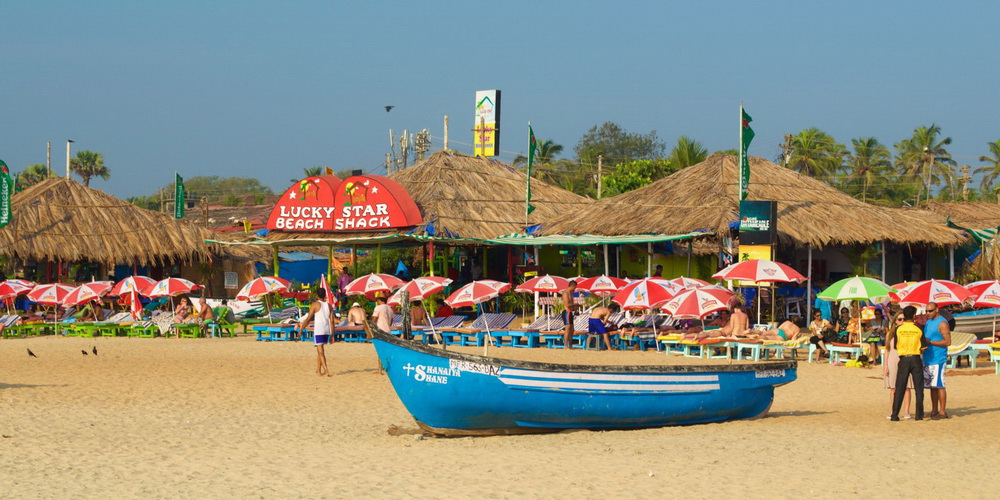
The vast green expanse of the Sahyadri mountain range ensures that Goa has an abundance of water. The sea and rivers abound in seafood - prawns, mackerels, sardines, crabs and lobsters are the most popular with the locals and the visitors.
Along with English which is widely spoken all over Goa, Konkani and Marathi are the state languages. The national language Hindi is also well understood in most areas around the state.
Goan cuisine is a blend of different influences the Goans had to endure during the centuries. The staple food in Goa is fish and rice, both among the Hindus and the Catholics. Unlike the Christian food the Hindu Goan food is not strongly influenced by the Portuguese cuisine.
Since the arrival of the Hippies in the sixties, Goa has been a major destination on the itinerary of international and domestic tourists.
The tourist season in Goa begins in late September and carries on through early March. The weather in these months is usually dry and pleasantly cool.
Then the weather gets fairly hot around May and by end of June, Goa receives the full blast of the Indian monsoon with sudden downpours and tropical thunderstorms. However it is also during the monsoon that Goa is probably at its most beautiful, with greenery sprouting all around.
Besides the natural beauty, the fabulous beaches and sunshine, travellers to Goa love the laid-back, peaceful, warm and friendly nature of the Goan people. sAfter all, more than anywhere else on planet earth, this is a place where people really know how to relax.
FAIRS & FESTIVALS
Goa has various religious mix of people and has number of holidays and festivals. During national holidays Banks and Post Offices may remain closed. Christian festivals occur on set dates. Hindu religious festivals follow the lunar calendar and therefore change from year to year. Following are some of the national, state and local holidays apart from local village events.
FEAST OF THE THREE KINGS
On 6th January the three villages of Reis Magos, Cansaulim and Chandor celebrate this festival with reenactment by local boys of the three kings arriving with gifts for Christ.
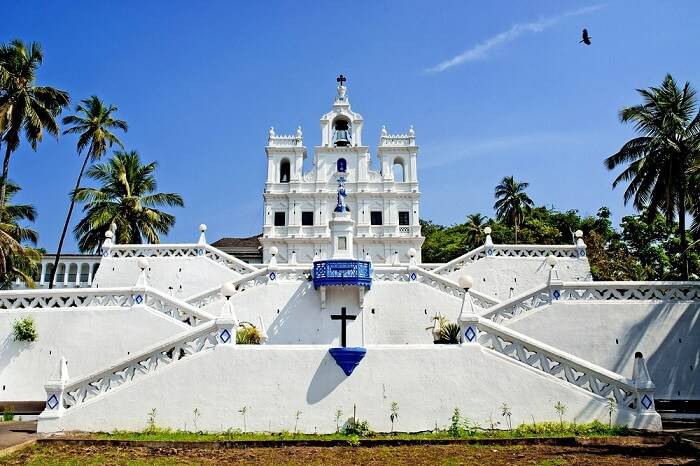
JATRA
The Jatra is the feast of the God to whom the temple is dedicated. Best at Shantadurga Temple at Fatropa in Quepem, at Bogdgeshwar Temple in Mapusa and Devki Krishna Ravalnath Temple at Marcela in Ponda. This festival is also celebrated in other temples of importance.
REPUBLIC DAY
Republic day on 26th January marks the anniversary of India's republic in the year 1950. In Delhi it is celebrated in spectacular way with enormous colorful military parade.
FEAST OF OUR LADY OF CANDELARIA
Popular Christian festival held on 2nd February at Pomburpa.
POP, BEAT & JAZZ MUSIC FESTIVAL
Held over two days in February at the Kala Academy-Panaji.
SHIGMOTSAV OR SHIGMO
Goa's version of Holi, this Hindu festival is held to mark the end of winter. It normally takes place on the full moon day of the month of Phalguna and is widely celebrated by gangs of youths throwing colored water and powder at one another. Tourist frequently become a target-it is in good humor just to excite the tourist. This is not a day to go our dressed in best cloths.

CARNIVAL
The original reason for the carnival was to celebrate the arrival of Spring and it is observed within the Catholic community as three days of partying before the start of Lent. In Panaji the festivities center around a procession of colorful floats which takes place on Sabado Gordo or Fat Sunday. The event is opened by the arrival of King Momo who makes a traditional decree ordering his subjects to forget their worries and have a good time.
VASANT PANCHAMI JATRA
Hindu's festival, best celebrated at Shantadurga temple in Queula at Ponda, in Mangesh temple at Priol, in Mahalsa Temple at Mardol which are in Ponda This festival is also celebrated in Ajoba Temple at Querim in Pernem and in Mahalaxmi Temple at Amone in Bicholim.
MAHASHIVRATRI JATRA
Hindu's festival, best at Siroda and Ramnath temples both in Pond and at Sanguem; also good at Harvalem, Kavlem and Mangesh Temples. This festival celebrates the birth of Lord Shiva.
URS OF SHAH ABDULLAH
Muslim's, death anniversary of saint Urs of Shah Abdullah. On this day of 17th February Muslims sing lyrical Muslim devotional songs called quawwalis, often sung through the night at Ponda.
RAMANAVAMI
The birth of Rama an incarnation of Vishnu is celebrated at the temple of Partagal in Canacona.
PROCESSION OF ALL SAINTS
At Goa Vellha on 5th Monday in Lent. Thirty status of the saints are brought out from storage and paraded around the neighboring villages. The main road through Goa Velha generally becomes blocked with the traffic as people from all over Goa are also drawn to the fair.
GOOD FRIDAY & EASTER
The Easter celebrations are marked by huge church services; the congregations often overflow into the streets or the services are held outside to accommodate everyone. Christian families mark the event with large clean gathering.
FEAST OF JESUS OF NAZARETH
Held in Sindao on the first Sunday after Easter.
FEAST OF OUR LADY OF MIRACLES
Held in Mapusa 16 days after Easter. This particular festival is famous for its common celebration by large numbers of Hindus and Christians.
BEACH BONANZA
From mid-April onwards successive Sundays see Colva Beach becoming the scene for this small festival featuring live music, dancing and entertainment.
YOUTH FLEET
Same as Beach Bonanza but on the Calangute beach.
MAHAVIR JAYANTI
Jain festival, celebrated by the strictly vegetarian Jain community. Marks the birth of Mahavir, the founder of Jainism, and is a public holiday. Celebrated grandly at Borim in Ponda.
IGITUN CHALNE
Occurring in May this is one of the most distinctive festivals in Goa and is specific to the temple of Sirigao in Bicholim Taluka. Igituna Chalne literally means fire-walking and the high point of the festival which occurs at night when devotees of goddess Lairaya walk across a pit of burning coal to prove their devotion.
FESTIVAL OF ST. ANTHONY
Held on 13th June The feast of St.Anthony Portugal's national saint is celebrated in Goa. This festival has taken on a particular local significance. If the monsoon has not arrived by the time of the feast day a statue of the saint is lowered into the family well for the arrival of the rain.
FEAST OF ST.JOHN THE BAPTIST
Held on 20th June. St.Anthony's feast day marks the onset of the rains, the Feast of St.John is a thanks giving for the arrival of the monsoon. The most obvious manifestation of the rains is the fact that the wells start to fill up again and to mark the event young men of the community jump into the water. Since each well owner by tradition has to supply feni to the swimmers the feast day is marked by increasingly high spirits.
FEAST OF SAINT PETER & SAINT PAUL
Held on 29th June. Another celebration of the monsoon, this time by the fishing community particularly in Bardez taluka. The fishermen tie their boats together to form rafts which serve as makeshift stages. After a church service in the morning and a large feast the festival of Sangodd is held. Tiatrs, folk dances and music are performed before an audience who watch from the banks of the river.
GOA STATEHOOD DAY
Celebrated on 30th of May, State holiday to celebrate Goa becoming the 25th state of Indian Union on May 30, 1987.
INDEPENDENCE DAY
On 15th August celebrates the anniversary of India's independence from the UK in 1947. The Prime Minister delivers an address from the ramparts of Delhi's Red Fort
FEAST OF ST. LAWRENCE
The feast day is to celebrate the end of monsoon and the reopening of the Mandove to river traffic.
GOKUL ASHTAMI
The celebration of Krishna's birthday. In some Krishna temples the deity is symbolically placed in a cradle.
BONDERAM
Celebrated on the island of Divar on the fourth Saturday of August. The festival consists of processions and mock battles which commemorate the disputes which took place over property on the island.
NAVIDADES
Held on 24th August. The offering of the first sheaves of rice to the head of state.
GANESH CHATURTHI
The Hindu festival is celebrated throughout the state and commemorates the birth of Ganesh. The festival can last for two and a half days. Clay models of Ganesh are taken in procession around the areas of the temples before being immersed in water. A period of fasting is observed.
FAMA SE MENINO JESUS
The feast is held at Colva on the second Monday of October and celebrates the 'miraculous' favor granted by the Menino Jesus which resides within the Church of Our Lady of Mercy in Colva.
GANDHI JAYANTI
Celebrated on 2nd of October, the birth of Mahatma Gandhi. Prayer meetings are held at the memorial site in Delhi. As a sign of respect it is a Dry Day and no alcohol is served.
DUSSEHRA/DHAROTSAV
Hindu's festival, this is extremely popular ten-day long festival begins on the first day of the Hindu month of Ashvina. The festival celebrates the triumph of good over evil and culminates in the burning of the effigy of the demon king, Ravana. In Goa, the main puja of this festival is performed at the place of work. Machinery, tool, vehicles etc., are cleaned and garlanded with flowers and worshipped.
DIWALI (DEEPAVALI)
This Hindu festival also known as the Festival of Lights is second in importance only to Ganesh Chaturthi and marks the victory of Good over Evil. Symbolically lamps are lit morning and evening within the homes of the worshippers.
GOVARDHANA PUJA
Hindu festival dedicated to those holiest animals the cow.
FEAST OF OUR LADY OF THE ROSARY
Celebrated on the 3rd Wednesday of November in Navelim's Church.
MARATHI DRAMA FESTIVAL
Takes place at Kala Academy from November to December.
FOOD AND CULTURE FESTIVAL
A five day festival held on any one of the beaches in November or December to highlight Goan cuisine and entertainment.
KONKANI DRAMA FESTIVAL
Held at Kala Academy during November and December.
TIATR FESTIVAL
Held at Kala academy during November.
FEAST OF ST.FRANCIS XAVIER
The feast is celebrated in Old Goa on 3rd December with processions and services. The feast of the patron saint of Goa is celebrated on the day he died in 1552. Preceding the feast, nine days of Novenas are held, attended by pilgrims from all over the world. Stalls selling sweetmeats, toys, clothing etc., line the streets.
FEAST OF OUR LADY OF IMMACULATE CONCEPTION
Held on or around 8th December in Panaji and Margao accompanied by a large fair.
CHRISTMAS DAY
Christmas is celebrated as a holiday throughout Goa and India. Goa's Catholics flock to midnight mass services traditionally called Missa de Galo or Cock Crow as they go on well into early hours of the morning. Christmas Day is marked with large family gatherings and feasting.
NEW YEAR'S EVE
Jubilant celebrations on the 31st of December, in the form of all-night street parties and beach parties anticipate the good things the New Year will bring.
ARTS & CRAFTS
Goa is a land of crafts and craftsmen, where aesthetic quality finds a natural expression. Goa has a rich and magnificent tradition of the classical arts. Over the years, Goans have excelled in poetry, music and the fine arts.
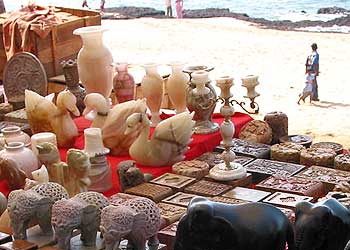
The exquisitely carved rosewood and teak furniture, the terracotta figurines, the classic brass items and the unique gold jewellery designs all speak of an age still valuable in this technology obsessed world.
The folk paintings of Goa have been traced to different places from ancient temples, churches and palatial manors to humble households. They mostly depict episodes from the epics - the Mahabharata and the Ramayana and the Puranas and also scenes from the New Testament.
During the Portuguese colonisation, local craftsmen played a major role in the development of the exquisite furnishings and decorations used in residential houses, churches and chapels. This art can still be seen the Christian Art Museum at Old Goa.
Goans have contributed greatly to the world of music. Many famous names on the Indian music scene originate from Goa. Famous singers such as Lata Mangueshkar and Kishori Amonkar in the classical variety and Remo Fernandes in pop music, are from Goa.
Konkani literature has produced many great names such as Bakibab Borkar who have contributed to the development of Konkani as a national language with some superlative writing.
Local craftsmen in Goa produce a wide variety of crafts ranging from terracotta pottery and figures to superb brass lamps and decorative items.
A large number of Goans have also played a major role in drama and Hindi film industry in the neighbouring state of Maharashtra.
PLACES TO VISIT
Goa Beaches
Goa is one of India's special tourist places that can boast of fantastic weather, fabulous beaches, wonderful people, mouth-watering cuisine, forts.
There are beaches far from human habitation with very basic or sometimes no facility for accommodation. Then there are some with ultra modern comforts like internet cafes, massage centers, gyms, swimming pools, night clubs, etc. With such an enormous choice, one might feel confused about which one to take.

Anjuna Beach: Anjuna, 18 kms from Panaji is a popular beach area adjacent to Chapora fort- it was the haunt of the flower generation in the sixties - and is still popular with the younger generation.
Calangute Beach: Calangute is the beach to which everyone heads for the moment they land in Goa. So it is natural that it is overcrowded in both in peak and off seasons.
Dona Paula Beach: 7 kms from Panaji. An idyllic picturesque spot. Command a fine view of the Zuari river and Mormugao Harbour. Water scootering facilities are available here.
Arambol Beach: Arambol Beach is 50 kms from Panaji. A unique beach in the North Goa, is both rocky and sandy beach and much sought after.
Palolem Beach: It’s a beach of white sand facing a blue bay between two headlands. The little wooded islands on the northern headland look interesting but as we’ve never ventured onto any of them we don’t know what landing on them would be like.
Agonda Beach: If you continue driving towards Panaji from Palolem, the next beach is Agonda. It’s long and lonely, fringed with palms and casuarinas and dominated by a large hill to the south.
Vagator Beach: This beautiful beach is located about 22 Kms from Panaji and is situated in Bardez taluka. This is part of a 30 km stretch of beach coastline along the west coast of Goa by the arabian sea that begins at Fort Aguada continues as Sinquerim beach.
Miramar Beach: This beautiful beach is located about 3kms from Panaji. It lies adjoining the estuary of the river Mandovi as it opens into the Arabian sea. It was originally known as the "Gasper Dias Beach".
Colva Beach: This is the most important beach in the south circuit equipped with all modern amenities like air-conditioned resort complexes, tourist cottages, discos, seashell artefact stalls, refreshment stalls, eateries, guest houses, expanding the village enormously.
Churches of Goa
Basilica Of Bom Jesus
One church at Goa in India which tourists never fail to visit is the Basilica of Bom Jesus in Old Goa which was built in 1605. The history of this Goan church is as interesting as the beautiful architecture that this church in Goa, India, is proud of. Basilica of Bom Jesus has now been declared a World Heritage Monument. The sacred relics of St.Francis Xavier are kept in this church. St.Francis Xavier, patron saint of Goa, died while on a sea voyage to China on December 2, 1552. As per his wishes, the following year, while transferring his remains to Goa, it was found that the saint's body was as fresh as the day it was buried. This miraculous phenomenon continues to attract the devout from all lands, and an Exposition or public viewing of his body every ten years attracts lakh of pilgrims.
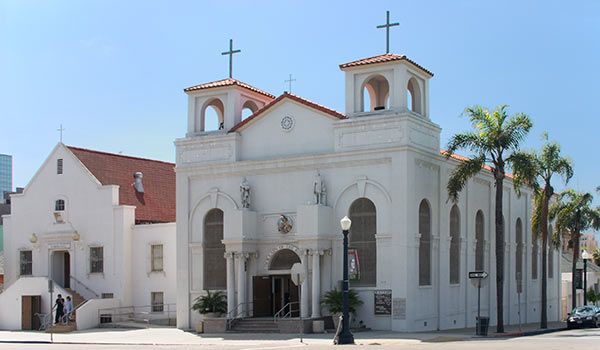
Church of Our Lady of Rosary
In Velha Goa or Old Goa, crowning a hill, which was known as the Holy hill, is one of the earliest churches, the Church of Our Lady of Rosary. In Panajim or Panaji, as Goa's capital is called today, the oldest Church is dedicated to Our Lady of Immaculate Conception. The huge Convent of Santa Monica, dating from 1606, was the first Nunnery in Asia. Today, after centuries of changing fortunes, it has been restored and is once again a residential convent.
The Rachol Seminary
The Rachol Seminary in South Goa has a chequered past. Originally a Muslim fortress it was first converted by the Portuguese into a church and later into a prison. In the late 16th century, it acquired respectability as a seminary for Theological Studies, with the Jesuits rechristening it from College of All Saints to the College of St. Ignatius Loyala, the name of their Founder.
The Se Cathedral
The Se Cathedral nearby is dedicated to St. Catherine, as it was on her feast day, 25th November 1510 that Alfonso de Albuquerque conquered Goa. Believers are awe-struck to hear of the Cross of Miracles, which is placed in the cathedral, its earlier church having been destroyed. People have had a vision of Christ on this cross and the rock on which it was found was said to spout water while, today, the cross is slowly growing. Earlier, it was at Se Cathedral that the sacred relics of St. Francis Xavier were shown to the public.
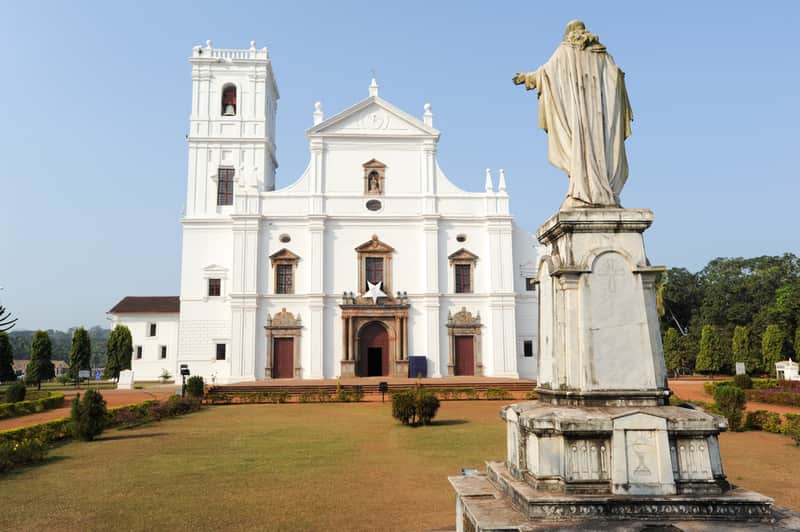
Church of St. Francis of Assisi
Not far away stands the beautiful whitewashed Church of St. Francis of Assisi, which today houses part of the archaeological museum. Exhibits include prehistoric items from a distant tribal past as also reminders of Goa Dourada, Golden Goa, also known as the 'Pearl of the Orient' or 'Rome of the East' during its heyday. It was the concentration of magnificent churches, symbol of a powerful conquering presence, which justified this last title. In fact, the Church of St. Cajatan, built by an Italian architect in 1651, was modeled in miniature on St. Peter's Basilica in Rome. Today a theological college is housed here.
The Reis Magos Church
Built in 1555, the church was once a mission center of the Franciscan Order of Monks. Also in Bardez Taluka, at Saligao, amongst picturesque surroundings, stands the Church of Mae de Dens or Mother of God. The statue after whom this church was named once occupied a convent, now no longer extant, and was known for its miraculous powers. This church is a fine instance of Gothic architecture.
The Church of St. Alex at Curtorim
This Church dates from the 16th century.
The Church of St. Anne
Situated at Talaulin Iltias, affectionately called Santana by the people, is dedicated to the Mother of Mary. It is situated on the right bank of the Siridao River.
Temples of Goa
Brahma Temple
It lies in the village of Brahma Carambolim. Dating from 5 AD, it is one of the few temples dedicated to Brahma to be found anywhere.
Shri Bhagavati Temple
In Pernem celebrates the Goddess Bhagavati Ashtabhuja, or eight-handed Goddess, one of the forms of Durga.
Shri Datta Mandir
Lies at Sanquelim, this temple is known for the miraculous cure for mental troubles, which the deity, the Hindu Trinity of Brahma, Vishnu, and Maheshwar, is said to offer.
Shri Damodar Temple
On the banks of the river Kushavati is a place of pilgrimage for Hindus and Christians alike. The waters of the river near the temple precincts are a cure for all ailments. Shri Damodar is known simply as Danubab by the faithful and he is, till today, the patron deity of Margao. The idyllic surroundings of Zambaulin make the visit quite memorable.
Shri Chandreshwar Temple
Atop the Chandranath Hill, this temple dates from the pre-Christian era, when this region formed part of the Boja capital of Chandrapur today's Chandor. The famous Shiva Linga is lit up by moonlight on the full moon night, and is said to become mystically bathed in water. Sri Chandreshwar or God of the Moon is so placed so to offer the visitor a wonderful view of the green valley below.

Devaki-Krishna Temple
Like many of Goa's temples, the Devaki-Krishna Temple at Marchel was moved here from two previous locations, to be safe from oppression. The beautiful and unusual image in black stone is of the baby Krishna on his mother, Devaki's hip. Could the Baby Jesus and his Mother, Mary, represented in so many of the neighboring churches here have given this temple its inspiration, or is it simply an astonishing coincidence of the overlapping of Western and Eastern traditions?
Shri Gomanteshwar Temple
Lies at Brahmapuri, this temple in old Goa, dates back to the Kadamba Kings who ruled Goa in the 5th century AD.
Gopal-Ganapati Temple
Near Bandona amidst lush green surroundings is the temple of Gopal-Ganapati. A modern temple, consecrated as recently as 1966, it is built on the spot where the Maratha king Sambhaji defeated the Portuguese army in 1683. The surprise defeat was believed to be a sign of the deity's protection of the rural. The image of Gopal-Ganapati was discovered quite accidentally at this historic battlefield and sheltered under a thatched-roof until recently.
Sri Mangesh Temple
One of the most celebrated and therefore most visited of Goan temples is dedicated to Sri Mangesh or Lord Shiva, the cosmic power of Perfection. A beautiful legend surrounding the name of the Lord tells how the Goddess Parvati, Shiva's consort, came to Goa in search of her divine spouse, who had left her alone in their mountainous home after a disagreement. Seeing her, Shiva took the form of a tiger, whereupon Parvati cried aloud: thrahi mam girisha! - O save me, Lord of the mountains - thereby seeking refuge in her lord. The words mam girisha transmuted to Mangesh. Thousands of believers come here annually, to take refuge in the great Lord Shiva, as Parvati had done.
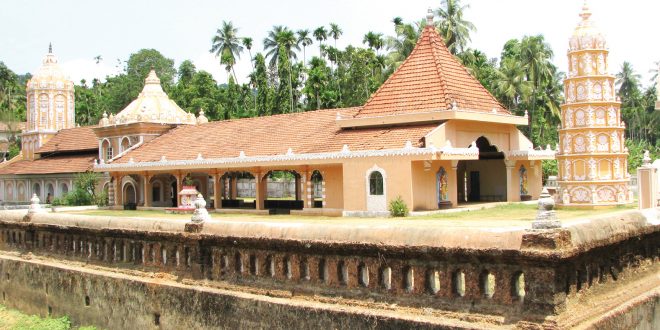
Shri Ananta Temple
Located at Veram is a temple dedicated to Lord Vishnu, the second god of the Hindu Trinity, whose role is that of preservation, just as Brahma's is of creation and Shiva's is of dissolution. This is the only Ananta Temple in Goa and therefore of special interest. Surrounded on all sides by water and beautiful countryside, the aspect of the temple site inspires tranquility and peace. For village folk, the pilgrimage could be undertaken for the purpose of exorcising spells, as the belief is that the Lord has the power to do so.
Shanta Durga Temples
Finally, pay your obeisances to three separate temples, all dedicated to the Mother Goddess, Shanta Durga. She is so named as she is said to have mediated in a dispute between her husband, Lord Shiva and the equally influential Lord Vishnu. Having established peace or shanty between the two, she acquired the somewhat paradoxical title of Shanta Durga. For Durga is traditionally a warrior-like Devi, with ten hands, armed with fierce weapons who, seated on a tiger, battles fiercely with the forces of evil on behalf of her devotees. Those who utter her name perform even the hardest tasks with ease and, in particular, she is invoked before undertaking a mission or journey. The principal Shanta Durga temples are at Fatorpa in Quepem taluka, which is visited by thousands of believers from all over Goa. The sumptuous temple at Kavalem provides lodgings like other temples too, and in famous for its interior. The third temple is at Dhargal in Pernem, amidst beautiful surroundings. The Goddess was moved here in 1550 AD for safety from the Inquisition. Perhaps her peace loving nature helped to restore harmony in the land of her adoption.
Temple of Tambdi Surla
The Temple of Tambdi Surla is one of the few religious structures in the state that survived Portuguese onslaught.
Monuments
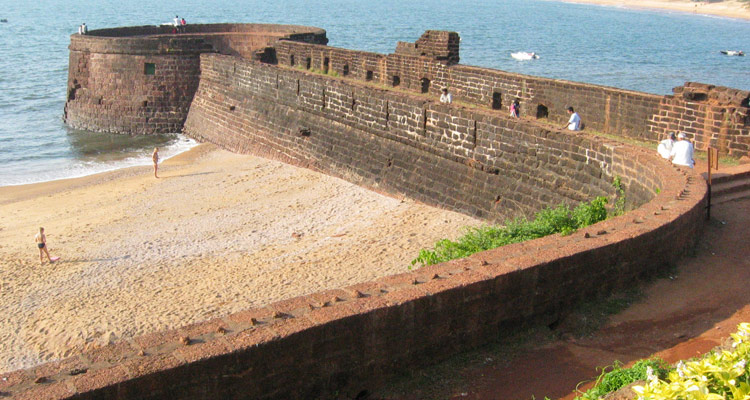
Fort of Aguada
Fort of Aguada is situated in the north of Goa, 18 km from Panaji. The Fort of Aguada was built by the Portuguese to prevent the entry of the enemy into River Mandovi and to protect old Goa from attacks. The fortification skirts the seashore. From the ramparts of Fort Aguada, you can get a fantastic view of the golden beaches running right up to the borders of the Indian state of Maharashtra. At the center of the fort is a circular lighthouse tower which was built in 1864. If you can manage to reach the top of the lighthouse, then you can catch some excellent view of the Cabo Raj Niwas. The Fort presently houses the central jail.
Cabo Raj Niwas
Cabo Raj Niwas, built in 1540 AD, is situated just opposite to Fort Aguada. This fortress housed the Franciscan monastery during the 16th century and now Cabo Raj Niwas is the official residence of the governor of Goa.
Cabo de Rama
Not far from Agonda beach is Cabo de Rama, untouched by most of the visitors in this region. The atmosphere of the fort creates a sense of history and drama that very few would fail to appreciate. The fort is named after Rama, hero of the Hindu epic Ramayana. According to the local legends, Rama stayed here with his wife Sita during the period of 12 ear exile.
Chapora Fort
Goa Chapora Fort is situated near the Anjuna beach in Goa. The Chapora Fort gives a splendid view of the Anjuna and Vagator beaches. The fort has been well preserved except for a few interesting ruins. Once, it was a domain of the Muslim rulers before the Portuguese wrested it.
Tiracol Fort
Drive along the full length of Goa's 130 km coast line and when you come to the last beach of Goa in India, Arambol, just look across the Tiracol river and you will find a pretty little fort which looks as if it has come out alive from a fairy tale. This fort has now been converted into a hotel. A beautiful little Goan church dominates the central court around which the fort of Tiracol rises: a living church full of light and quiet elegance. Cross the court and walk up the narrow stone stairs through short passages into split level rooms which follow the contours of the headland: old furniture, superb views over the river Tiracol and the beaches and out to the blue horizon of the sea. The Portuguese had sailed in from there, established themselves in the old conquests like this one, taken over an existing outpost, converted it to a fort to repulse the latest technique of attack. Other Places of Interest.

Bondla Sanctuary
There is this little Bondla Sanctuary at Goa in India with its unique wild life rehabilitation centre which is a major tourist attraction. Here the animals which have been orphaned or injured, wander into inhabited areas where they get tender loving care. And this way they, thrive. There has been a population explosion of porcupines who now rustle around with their usual, bad-tempered bustle. However, Bondla's greatest attraction is its profusion of birds. In twenty minutes you can spot 11 different species including a Grey Hornbill.
Bhagwan Mahavir Wildlife Sanctuary
Thirty per cent of Goa, India, is covered with dense forests and though tigers and elephants do wander into the 240 sq. km of the Bhagwan Mahavir Wildlife Sanctuary in Goa, they don't stay for long: possibly because there isn't enough of their favourite food available or perhaps because centuries of hunting by the Portuguese had built in an instinctive fear for these forests among the larger animals. However, if lucky, you can spot Indian bison, the Gaur, in the forests of Molem in Goa, a part of this large sanctuary.

Dudhsagar Waterfall
Once out of the dense forests of the sanctuary in Goa, India, you can emerge into the dramatic Goan valley of Dudhsagar. A tributary of the Mandovi river cascade down for 600 metres. Its water gushes under a railway bridge and foams white towards the spectators. If you cross the bridge by train you will chug over the mid-point of the highest cascade and, if the wind is right, you'll feel the spray in your compartment. But if you see the falls from below, this 'ocean of milk' which is what Dudhsagar means, seems to be pouring out of the sky!
Mayem Lake
The Mayem Lake is the favourite escape of the local Goans who pack their picnic baskets and set off to this delightful haunt.
Ancestral Goa
The Ancestral Goa project, the brainchild of Goan artist, Maendra J. Alvares who has used his family's ancestral property to keep Goa's culture alive and is a place worth visiting as any lay visitor can get a glimpse of Goa in its original grandeur and authentic form. Dedicated to the preservation of art, culture and enviroment and inorder to preserve Goa's past and its rich traditions this magnificent project named "Ancestral Goa" is the result of a lot of meticulous research, planning and hardwork. It opened to the public in April 1995. Ancestral Goa is miniature Goan Village as it would have existed 100 years ago. It is located on a nine acre verdant hillock at Loutulim ins South Goa, about ten kilometers from Margao. This place imparts a culture based education about the roots and heritage of Goa. Local feasts and festivals are celebrated with traditionsl style and fervour. A visit to Ancestral Goa on any of the feast days, allows for a pure experience of Goan customs and lifestyles. The Eat-out offers a menu full of traditional Goan Specialties. Local vegetables, fish and sweets are treats to be indulged in.
Important sights in Ancestral Goa
Big Foot Art Gallery, Handicraft Centre, Sant Mirabai, Big Foot, The Dance Floor, Casa De Dona Maria, Anand Lotlikar's Ghor, Goan farmer's House, Escola de Musica (Music School), Sant Khuris, Rakandar, Boca da Vaca, Goan Fisherman, Goan Coconut Husker, Bhati (Distillery), Tinto, Dovornem, Taverna (The country liquor shop), The Khumbar, The Chamar, The Mahar, The Barber, Rubber Plantation, Spice and Fruit Garden, Bird Habitat
